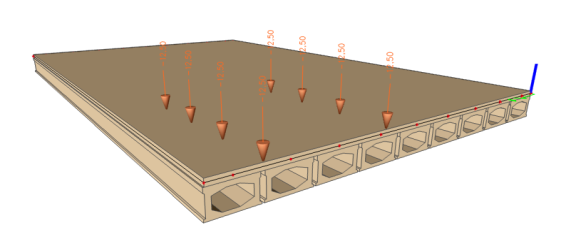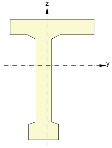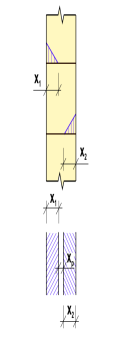Bridge Load Rating
Most of the unique innovations have been introduced due to the fact that a man is lazy and wants to make his life easier than before. Undoubtedly bridge load rating is a laborious hand-iterative process, especially when it comes to reinforced and/or prestressed concrete bridges. The engineer can spend days and weeks trials and errors in the estimation of bridge load-carrying capacity. The problem lies in the determination of load-bearing capacity of cross-section subjected to the combination of normal and shear forces, bending and torsional moments. Due to the different effect of dead and live loads and the non-linear behavior of concrete, the problem becomes non-linear and its solution requires the use of suitable iterative method.
That is probably why my friend, excellent bridge engineer and user of IDEA StatiCa, came to me with the request to help him and his colleagues with this tedious task…
Optimized iterative solution was implemented into IDEA StatiCa software and it results in new module available in version 7.
Bridge load rating is the calculation to determine the safe live load carrying capacity of the bridge. Due to the facts that load schemes usually differ from traffic loads defined in design codes and materials possibly suffer from the deterioration, different partial safety factors of materials and loads and different combination factors are used.
Benchmark example
A load rating benchmark example was performed on a simply supported KA61prestressed concrete side-by-side box-beam bridge with a span length equal to 12m and with the cross section shown above.
The analysis of moving loads on the bridge beams has been performed in software SCIA Engineer. Based on this analysis, the critical effect of moving loads on particular bridge beam was identified and internal forces in critical moving load cases were exported into IDEA StatiCa. Structural model of bridge beam was created in IDEA Beam application including the design of tendon and reinforcement.
Combinations for bridge load rating analysis are generated automatically based on the bridge load groups. Program runs automatic iterative calculation respecting the settings of the analysis. Results of analysis appear automatically after the calculation. Results of analysis are presented as summary for critical checks and sections, and also for particular type of load bearing capacity of bridge load rating analysis - Vn – normal, Vr – reserved, Ve – exceptional.
In-plane restraint of out-of-plane flexure
The option can be switched on/off in Construction stages – settings.
Results of structural analysis (TDA)
Deformation of the beam due to the self-weight in stage Storage yard (Supports at the ends)
uy – extreme 0.424mm
uz – extreme -0.605mm
Deformation in stage Final supports due to uniform load -10kN/m
Only deformation uz
Deformation uy and rotationjxis fixed
uy = 0
uz – extreme -1.124mm
Results in RCS – check of sections
Settings in Construction stages in RCS mirror the settings in the Beam module.
The effects of extreme internal forces calculated in stage Storage yard:
- 3D bending
- rotation rx andjzare not zero
The effects of extreme internal forces calculated for stage Final support:
Out-of-plane flexure is prevented starting from this construction stage. Therefore the assessments of cross-section disregard any increments of moment Mz, which appear since that construction stage. Of course that total effects can result in out-of-plane flexure, which appeared in the increments before in-plane restraint was applied.
- 3D bending
- Increment ofjzis zero
The effects of extreme internal forces calculated for stage End of design working life:
- 3D bending
- Increment ofjzis zero
Relaxation tables
The total relaxation of prestressing steel at infinite time and the development of the relaxation loss over time have often been provided by the producer of the prestressing reinforcement in the form of what is called relaxation tables. And we had always worked with relaxation tables in our professional life before Eurocode introduced a formula instead. It seemed to be a big progress -easy programing, easy work. The problem is that the formula does not fit the real behaviour of prestressing reinforcement manufactured by different producers. That is also why the use of that simple formula is not allowed in Germany. And that is why we introduced user-defined relaxation tables into IDEA StatiCa version 7.
Generator of bridge combinations in BIM
Users of IDEA StatiCa praised the generator of bridge combinations, which was implemented in IDEA StatiCa Beam in version 6. They said repeatedly that it is better than in programs of our competitors. That is why they asked for the implementation of the generator into BIM module so that they can use it after they import the results of load cases from linked 3D programs.
That is why the possibility to define bridge load groups and to generate load combinations was implemented into IDEA StatiCa software in version 7. Above that the combinations can be exported into Midas Civil via mct file.
Liquid retaining and containment structures - improvements
The check of cracks according to EN 1992-3 is improved so that the program determines automatically if the depths of concrete compression zone from opposite sides overlap each other or not. This happens in the case that the cross-section is loaded from both sides (alternately for different combinations).
Unilaterally stressed cross-section
Both sides stressed cross-section, depths of concrete compression zone overlap
Both sides stressed cross-section, depths of concrete compression zone do not overlap
RCS - possibility to check one extreme of the section only
Stiffness - improvements
New possibilities to calculate the stiffness and curvatures of prestressed cross-sections were introduced in version 7 – Both short-term and long-term stiffness can be calculated. Curvatures caused by the shrinkage can also be calculated.
Link to SAP 2000
Simplified UI of RCS
New user interface is optimized to be more intuitive and simple. The Navigator bar was reduced to provide basic program function and the Checks are accessible via Result command.
































